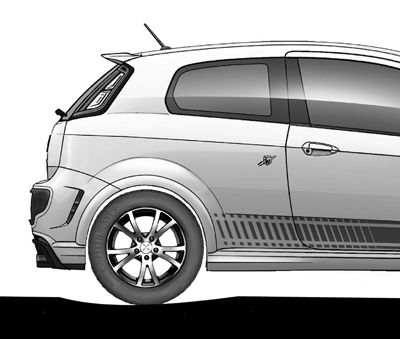When the tires of a car or truck roll over a roadway, the maximum pavement deflection is just behind the path of travel. This has the effect of making the vehicle’s tires roll
Image: Mehdi Akbarian |
 |
CIVIL ENGINEERS FIND SAVINGS WHERE THE RUBBER MEETS THE ROAD
Written by Denise Brehm
Massachusetts Institute of Technology
Study shows that pavement deflection under vehicle tires makes for a continuous uphill drive that increases fuel consumption.
CAMBRIDGE, Mass. — A new study by civil engineers at MIT shows that using stiffer pavements on the nation’s roads could reduce vehicle fuel consumption by as much as 3 percent — a savings that could add up to 273 million barrels of crude oil per year, or $15.6 billion at today’s oil prices. This would result in an accompanying annual decrease in CO2 emissions of 46.5 million metric tons.
The study, released in a recent peer reviewed report, is the first to use mathematical modelling rather than roadway experiments to look at the effect of pavement deflection on vehicle fuel consumption across the entire U.S. road network. A paper on this work has also been accepted for publication later this year in the Transportation Research Record.
By modelling the physical forces at work when a rubber tire rolls over pavement, the study’s authors, Professor Franz-Josef Ulm and PhD student Mehdi Akbarian, conclude that because of the way energy is dissipated the maximum deflection of the load is behind the path of travel. This has the effect of making the tires on the vehicle drive continuously up a slight slope which increases fuel use.
The deflection under the tires is similar to that of beach sand underfoot: With each step, the foot tamps down the sand from heel to toe requiring the pedestrian to expend more energy than when walking on a hard surface. On the roadways, even a 1 percent increase in aggregate fuel consumption leaves a substantial environmental footprint.
Stiffer pavements, which can be achieved by improving the material properties or increasing the thickness of the asphalt layers, switching to a concrete layer or asphalt-concrete composite structures, or changing the thickness or composition of the sublayers of the road would decrease deflection and reduce that footprint.
When the tires of a car or truck roll over a roadway, the maximum pavement deflection is just behind the path of travel. This has the effect of making the vehicle’s tires roll
Image: Mehdi Akbarian |
 |
“This work is literally where the rubber meets the road,” says Ulm, the George Macomber Professor in the Department of Civil and Environmental Engineering. “We’ve got to find ways to improve the environmental footprint of our roadway infrastructure.
Previous empirical studies to determine fuel savings all looked at the impact of roughness and pavement type for a few non-conclusive scenarios, and the findings sometimes differed by an order of magnitude. Where do you find identical roadways on the same soils under the same conditions? You can’t. You get side effects. The empirical approach doesn’t work. So we used statistical analysis to avoid those side effects.”
The new study defines the key parameters involved in analyzing the structural (thickness) and material (stiffness and type of subgrade) properties of pavements. The mathematical model is therefore based on the actual mechanical behavior of pavements under load. To obtain their results, Ulm and Akbarian fed their model data on 5,643 representative sections of the nation’s roadways taken from Federal Highway Administration data sets. These data include information on the surface and subsurface materials of pavements and the soils beneath as well as the number, type and weight of vehicles using the roads. The researchers also calculated and incorporated the contact area of vehicle tires with the pavement.
Ulm and Akbarian estimate that the combined effects of road roughness and deflection are responsible for an annual average extra fuel consumption of 7,000 to 9,000 gallons per lane mile on high volume roads, not including the most heavily travelled roads, in the 8.5 million lane miles making up the U.S. roadway network. They say that up to 80 percent of that extra fuel consumption, in excess of the vehicles’ normal fuel use, could be reduced through improvements in the basic properties of the asphalt, concrete and other materials used to build the roads.
“We’re wasting fuel unnecessarily because pavement design has been based solely on minimizing initial costs more than performance, how well the pavement holds up, when it should also take into account the environmental footprint of pavements based on variations in external conditions,” Akbarian says. “We can now include environmental impacts, pavement performance and, eventually, a cost model to optimize pavement design and obtain the lowest cost and lowest environmental impact with the best structural performance.”
The researchers say the initial cost outlay for better pavements would quickly pay for itself not just in fuel efficiency and decreased CO2 emissions, but also in reduced maintenance costs.
“There’s a misconception that if you want to go green you have to spend more money, but that’s not necessarily true,” Akbarian says. “Better pavement design over a lifetime would save much more money in fuel costs than the initial cost of improvements. The state departments of transportation would save money while reducing their environmental footprint over time because the roads won’t deteriorate as quickly.”
This research was conducted as part of the Concrete Sustainability Hub at MIT which is sponsored by the Portland Cement Association and the Ready Mixed Concrete Research & Education Foundation with the goal of improving the environmental footprint of that industry.
“This work is not about asphalt versus concrete,” Ulm says. “The ultimate goal is to make our nation’s infrastructure more sustainable. Our model will help make this possible by giving pavement engineers a tool for including sustainability as a design parameter just like safety, cost and ride quality.”
